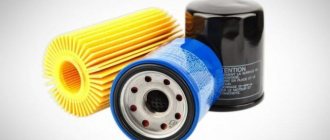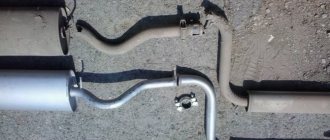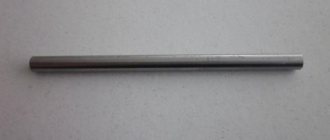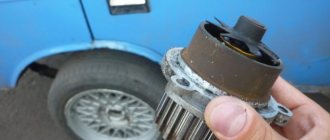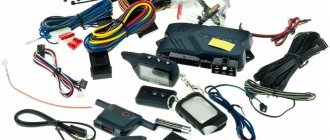The exterior of a car worries owners no less than its appearance, so they spend a lot of time, effort and money to maintain the interior in its original condition. Since the main material in the interior is plastic, car owners should pay enough attention to its restoration. If you know the basic methods, then you can do this work yourself. It is possible to replace a worn part, but some plastic parts are quite expensive, so it will be much more profitable to restore the interior plastic . More details about the methods of blackening the plastic of a car interior will be discussed in this article.
Plastic recovery methods
There are several ways to improve the appearance of plastic parts, thereby extending the life of the car interior. The most effective of them include a plastic restorer, the use of a polish, a plasticizer gel or a special film. You can also restore the appearance of plastic by heating it with a hair dryer. Now in more detail about each of the methods.
How to restore interior plastic
Plastic restorer
Used to restore surfaces such as vinyl and plastic. The principle of operation of the restorer is to completely fill existing scratches. The substance penetrates deep into uneven areas and displaces the dirt accumulated there. Immediately after the restorer has dried, you need to clean the surface using special wipes. If necessary, the procedure can be repeated.
Doctor Wax - plastic restorer
Application of polish
Polish is great for covering up minor scratches. It is also used as a final step after using other means. Depending on the color of the plastic, you need to purchase a certain type of polish. Such products contain coloring pigments that additionally mask damage.
Polish for car interior plastic
Heating with a hairdryer
Heating with a hairdryer is excellent for restoring the interior dashboard. The essence of this method is the prolonged exposure of high temperature to the damaged surface, as a result of which the plastic melts slightly and, as a result, becomes level. The required temperature can only be achieved using an industrial hair dryer.
Hairdryer for scratches on plastic
Note! It is not recommended to use a hair dryer on painted surfaces. Also, this method will not be effective in removing large scratches.
Gel plasticizer
After application, the gel imitates the texture of the surface, thereby restoring the damaged area. The gel plasticizer is used as follows:
- the product is applied to an undamaged plastic surface;
- a texture pattern appears on the gel after complete hardening;
- the resulting helium cast is applied to the area to be restored;
- the impression is pressed tightly against the plastic;
- a texture pattern is “imprinted” on the surface.
Gel plasticizer
Gel plasticizer gives the desired result only when restoring a small area of damage. If the plastic is worn out enough, then you need to choose another method.
Restoration of car interior elements
Interior repair technology
All actions when renovating the interior are similar. And yet there are nuances. And the quality of all repairs and the appearance of your now new salon depend on these nuances.
Instructions are included with each material purchased. When purchasing, check its availability. This is not just a piece of paper. It sometimes contains the most valuable information. Don't be afraid to take the time to study the manufacturer's instructions. It will pay off later. The restoration of the interior itself follows a simple scheme: they found damage and repaired it using repair materials. If the interior is made of leather, painting is possible. Only start painting when you are confident that you can handle it. Don't be afraid to experiment. In any case, there is a safety first option, which is never too late to resort to.
Kolodiychuk Andrey
, especially for
Plastic restoration products
You can restore the interior plastic using degraders. These are special products for restoring plastic elements. Below are the most effective blackeners from different manufacturers.
Plastic restoration products
Table. Review of plastic restoration products.
| Product name, photo | Description |
| DoctorWax | An excellent ink designed to restore not only plastic interior elements, but also the car body. DoctorWax can be applied to paintwork. |
| Sonax | German restorer for rubber and plastic surfaces from a German manufacturer. Sonax also has a glossy effect. |
| Runway | Polish in the form of milk from the famous American manufacturer NOWAX. The product is very easy to use. It is enough to spray it on the surface to be restored and treat it with microfiber. |
| Meguiar's | Another representative of the American market. Meguiar's can be used for restoration of plastic and rubber. The product is also effective in restoring vinyl. |
| QuickWax | Black polymer for plastic restoration. In addition to the blackening effect, QuickWax is also able to protect the surface from moisture. |
On a note! The average cost of a reducing agent in a 500 ml container is 600-750 rubles. But if you buy 330 ml, the price will be lower - within 300 rubles.
Let's sum it up
High-quality restoration of the car interior can be performed at specialized or universal service stations. But in most cases, car owners in our country tend to do such work themselves, since they are not too willing to pay a lot of money for the services of specialists. Therefore, there are several dozen methods for solving each problem, among which you will have to choose the most suitable one for all the features.
High quality interior is very important for a car owner. In many cases, we stop paying attention to the shortcomings that have been in the salon for a long time, but every time we look at problem areas, we remind ourselves of the need to correct them. Therefore, it is better to immediately begin restoring the interior and carry out this process efficiently. You can install new interior parts, supply used plastic parts from disassembly, or try to polish old versions of parts. What methods of car interior restoration did you use in your vehicles?
DIY plastic ink
There are various recipes for making ink at home. Such products cost little, around 80 rubles, but some of them are as effective as store-bought products. To prepare plastic ink, you need to prepare 6 tubes of glycerin, clean water and a small bottle with a spray bottle.
DIY plastic ink
The instructions for preparing the interior plastic restorer are as follows:
- water is mixed with glycerin in a plastic bottle;
- the bottle is tightly closed and shaken;
- a sprayer is installed;
- The ink is applied to the cleaned surface.
How to prepare plastic ink
The finished product does not have a rich black tint, but it can be used to mask small scratches on the surface of the plastic. If necessary, home restorer can be reapplied.
Possible damage
Direct sunlight and excessive heat will dry out leather trim. It dries out, cracks, and tears.
The most common defects in leather upholstery:
- punctures;
- burns;
- cuts;
- spots;
- ingrained dust;
- ruptures;
- abrasions;
- scratches;
- loss of color;
- cracks.
Fixable upholstery problems are caused by the leather losing its elasticity due to drying out.
Restoring plastic with polish
Step 1. Prepare cleaner and polish. In this case, products from are used, but if you wish, you can take another brand.
Preparing cleaner and polish
Step 2. Dilute the concentrate with water in a ratio of 1:10.
Diluting the concentrate with water
Step 3. Pour the finished product into a plastic bottle and install the sprayer.
Installing a sprayer on a bottle
Step 4. Apply a layer of cleaner to the surface to be restored.
Applying a layer of cleaner
Step 5. Wait 20-30 seconds for the product to be absorbed into the interior material.
The product must be absorbed
Step 6. Wipe the plastic thoroughly with a regular dishwashing sponge.
Processing plastic with a sponge
Step 7. Using a wet cloth, carefully remove any remaining product from the surface.
Removing product residues
Step 8: Dry the plastic surface using a clean rag.
Wiping the plastic surface with a rag
Step 9. This is what the plastic looks like after cleaning.
Plastic after the cleaning stage
Step 10. Apply a thin layer of matte polish to the cleaned surface. The right side is polished, while the left side is only cleaned (for comparison).
Applying matte polish
Step 11. Rub the polish with a sponge to distribute the polish evenly. Then wait 5 minutes for the product to be absorbed.
Distribution of polish over the surface
Step 12. Clean the surface with a dry cloth. You need to rub in until the matte effect is completely achieved.
Wiping the surface with a dry cloth
Step 13: Done! The plastic has been restored and is ready for use. It is recommended to repeat this procedure every 2-3 months, and then the salon will always look like new.
The interior plastic panel has been restored
Official registration of business
So, we have familiarized ourselves with the list of services for reupholstering salons, let’s move on to registering a business. To officially run a business, it will be enough to register as an individual entrepreneur. Typically, LLCs are opened only by large companies that simultaneously engage in tuning and servicing vehicles.
Suitable codes from the list of business activity classifiers OKVED code:
- 45.20.2. Maintenance and repair of other vehicles;
- 45.20. Maintenance and repair of vehicles;
- 29.32.1 Manufacture of seats for motor vehicles
Reanimation of damaged plastic
Step 1. Remove the plastic interior elements that need to be restored. The removed parts will be much easier to process.
Removing plastic interior elements
Step 2: Thoroughly wipe the plastic surface with a dry cloth to remove any layer of accumulated dirt.
Cleaning the plastic surface from dirt
Step 3. This is what the cleaned surface should look like. Now you can begin the restoration.
The part is cleaned and ready for restoration
Step 4: Prepare a can of black spray paint. You will also need a plastic primer.
Preparation of materials for restoration
Step 5. Wear rubber gloves before starting the process, as working with paint without protection is not recommended.
Putting on protective gloves
Step 6. Degrease the surface of the part before applying paint. This is necessary to ensure reliable fixation of paints and varnishes.
Surface degreasing
Step 7. Repeat the degreasing procedure with all dismantled elements.
Degreasing of all dismantled elements
Step 8. After the surface has dried, apply a layer of primer, shaking the can thoroughly before doing this. The product must be applied in accordance with the manufacturer's recommendations (you will find all the necessary information on the can).
Applying a layer of primer
Important! The primer's job is to create adhesion between the surface of the plastic part and the paint layer.
Step 9. Prime other elements as well. After this, the parts should dry well.
Drying the primer layer
Step 10: Shake the spray paint can and paint the first element. To make the paint adhere better, it is advisable to warm up the can (approximately to eating temperature).
Spray painting parts
Step 11. When applying a layer of paint, the can must be held at right angles to the surface to be painted.
Applying paint at right angles
Step 12. Wait for the paint to dry. In sunny weather, the part can be placed outside to speed up the drying process.
Drying the paint layer
Step 13. This is what the plastic element looks like after painting.
The part is painted and looks like new
Step 14. Paint the remaining parts in the same way.
Painting the remaining dismantled elements
Step 15. Interior parts are painted and ready for installation. Now they can breathe new life into the car interior.
Interior plastic restored and ready for installation
Why is it important to have a beautiful and well-maintained car interior?
Restoring a car interior with your own hands must be of high quality. If you decide not to pay money to specialists, but to carry out your own restoration, make sure of the highest quality of the work performed and excellent materials purchased. The quality of the interior will always be a determining factor in your mood behind the wheel of a car. Among the important points it is worth remembering the following features:
- the visual state of the car interior shapes the driver’s mood for the whole day, and it’s better to let this mood be good;
- problems constantly remind you and make you think about unfulfilled dreams or unfulfilled tasks;
- a damaged interior is often inconvenient to use, defects constantly interfere with normal operation;
- you lose confidence in your car and stop enjoying driving it, feeling ashamed in front of your passengers for the shortcomings.
Of course, each person will have their own arguments in this case. It’s difficult to say that every driver is ashamed of any interior defects, but it’s much more pleasant to drive a car in which everything is great. This gives you a certain self-confidence and allows you to pay more attention to the road and the trip, and not to any imperfections in the interior of your car. We offer a short video on how to paint interior elements with structural paint:
Masking plastic defects with carbon paper
Step 1. During use, such scratches appear on the car doors. They are especially active on budget car models, where manufacturers use hard plastic.
Scratches on the door plastic
Step 2. Prepare several sheets of tracing paper and rubber gloves for work. Gloves are necessary because tracing paper can get dirty.
Tracing paper for plastic restoration
On a note! Before work, be sure to clean the surface of the plastic. To do this, you can use a soap or foam solution.
Step 3. Place a sheet of carbon paper on the surface to be treated and begin to intensively press the plastic.
Rubbing plastic with carbon paper
Step 4. Rub surfaces in different directions. As work progresses, small scratches become less noticeable.
Changes after a few seconds of work
Step 5. Treat all problem areas on the plastic surface. If necessary, take a new sheet of carbon paper.
Treatment of problem areas
Step 6. The plastic has been restored and is not much different in appearance from new. One door requires 5 to 10 minutes of time.
Plastic restored using tracing paper
Staff
At the start, many people start a business of reupholstering interiors themselves, but as the volume of work increases, it becomes problematic to cope on their own. The easiest way is to foresee all the nuances in advance and form a team, delegating most of the tasks to hired employees.
- Fitting technicians.
To reupholster the interior, you will need to invite 1-2 fitting technicians who will take on the work associated with the dismantling and subsequent installation of interior elements. It is imperative that technicians have the necessary skills to work specifically with car interiors - ordinary experience in working at a car service center will not help. One careless action and you can damage an expensive airbag. - Seamstress.
To sew door and seat upholstery, you will need a professional seamstress who will be engaged in the manufacture and sewing of products. Wages are usually piecework and depend on the amount of work done.
Additional recommendations
To create a dense and uniform coating, you must use only high-quality inks. Experts recommend buying products in small bottles with a sprayer. This will reduce the consumption of the substance. Work should be performed with gloves and closed clothing to avoid contact of the product with exposed skin.
Restoration of interior plastic
Important! The optimal distance to the surface during spraying is 25-30 cm. Compliance with this rule will prevent the appearance of streaks.
Results of do-it-yourself interior plastic restoration
It is not difficult to use restorative products, so if you want to improve the condition of your car’s interior, then you don’t have to go to a car service center and overpay. You just need to choose an effective remedy, trying not to save too much, and also allocate some free time. And you're done! The salon looks like new again!
Main causes of wear:
1. When driving a car for a long time, parts quickly wear out from contact with passengers and the driver himself:
- Leather seats and steering wheel are subject to mechanical friction.
- The interior trim becomes covered with a coating of dust, smoke and dirt.
- Plastic coated surfaces are scratched.
2. The condition of the car interior is affected by external weather conditions:
- Low and high temperature differences.
- Ultraviolet healing.
3. An accident is the most destructive cause, as it leads to severe damage to the interior.
Work order
Let's consider the most complete cycle of work necessary to restore a damaged chair. If we are talking about minor cosmetic repairs of cracked or torn upholstery, complete dismantling of the chair should not be carried out.
Removing and disassembling the seat
The seat should be removed from the interior and completely disassembled.
It is most convenient to do the work on a table, so that you can lay out all the parts and not get confused later during assembly.
Keep a portable vacuum cleaner handy as a lot of dust tends to accumulate inside the seat. It is better to carry out work in a protective dust respirator or in a regular gauze bandage.
The ultimate goal of disassembling a chair is to remove the cushion and back from the frame. First, all external fastenings are removed, and then the upholstery is removed.
The upholstery is removed using sharp scissors or a utility knife, which is used to rip the seams
When removing the upholstery, remember that in some places it may be glued, so you should remove it carefully. The glued areas can be soaked using solvent or regular gasoline.
When dismantling, it is better to sign the disassembled parts so that there are no hiccups or errors during the assembly of the chair after the repair is completed.
Cutting new parts
In order to cut new parts from stored fabric, it is convenient to use old parts from the removed trim. They need to be placed on top of the fabric prepared for cutting and outlined as accurately as possible with a thin chalk or marker line. At this stage, the accuracy of the lines is most important, as well as the coincidence of the pile directions of the new and old parts.
You should also pay attention to how much the edge of the fabric frays when cut. The fabric should be cut with the sharpest possible scissors, and best of all, with an electric knife, which, when cut, simultaneously burns the edge. If there is no electric knife, a fresh cut of loose fabric can be carefully burned using a lighter, trying to prevent excessive ignition
If there is no electric knife, a fresh cut of loose tissue can be carefully burned with a lighter, trying to prevent excessive ignition.
Connecting the parts of the new case
The cut out parts are sewn together with thread or fastened with a glue gun. You can combine the two methods by first connecting the parts by gluing, and then stitching them over the adhesive joint with threads.
When using a glue gun, you need to carefully study the instructions and find out whether its use on a particular type of upholstery material is acceptable. It is best to check in advance on a piece of fabric how tightly the glue sticks, and also make sure that it does not damage the structure of the fabric.
The parts must be connected in such a way that their edges are on the wrong side of the upholstery. Distortions and folds when connecting are unacceptable.
Each stitched seam in the new upholstery should be beaten with a hammer on a soft foam base so that the seams do not puff up.
.
Replacing foam pads
When replacing the filling in a seat cushion, be especially careful to ensure that all voids are filled. If, after finishing work, there are unfilled corners in the seat, such a chair will very quickly become deformed, become uncomfortable, and all the work will have to be done again
For this work, foam rubber with a base of woven material on one side is suitable.
It is better to give preference to materials of those brands that are resistant to compression and last a long time. Some car enthusiasts prefer to use polyurethane foam as a filler for seat cushions.
The parts of the new seat upholstery are placed on foam rubber. In this case, they do not use a brush, which will glue the inside of the foam rubber, but a special adhesive spray, which will be distributed only over the surface of the material and glue it to the fabric, but will not spoil the foam rubber itself.
Assembling the chair
The chair should be assembled in the reverse order of its disassembly. First you need to connect the seat hinges, assemble the cushion and pull the cut and sewn upholstery over it. The seat and cushion are also connected by hinges and secured with screws.
The assembled chair is installed in its place. Now all that remains is to steam the new upholstery so that it acquires its final well-groomed appearance. This completes the seat repair.
Machine Ceiling Upgrade
Upgrading the ceiling trim of a car is a very important point in tuning the interior. Most often, the factory ceiling lining is made in light shades, which fade over time, acquiring an unflattering appearance. The situation can be corrected by reupholstering, for which carpet is usually used. This material is very practical and inexpensive.
VAZ ceiling (carpet upholstery)
First you need to dismantle the old upholstery. It is advisable to perform this procedure as carefully as possible in order to make a pattern from the carpet using a factory template. After this, the ceiling surfaces are cleaned and degreased.
For reliability, glue is applied to the ceiling, after which the pattern is secured using standard clamps. All that remains is to wait for the glue to dry, after which the procedure can be considered complete.
Carpet ceiling lining
